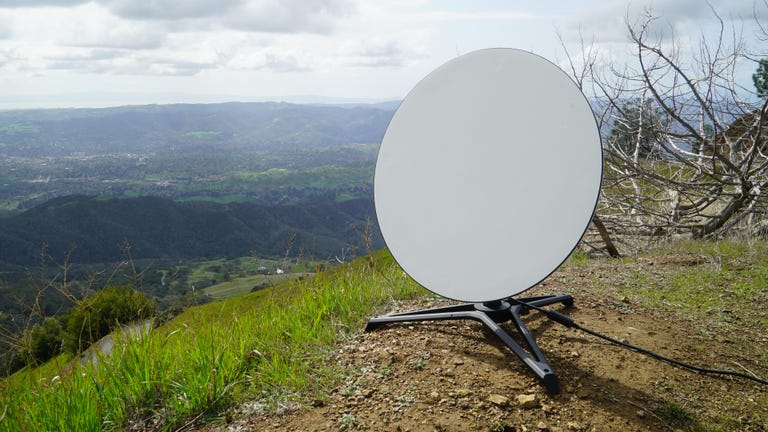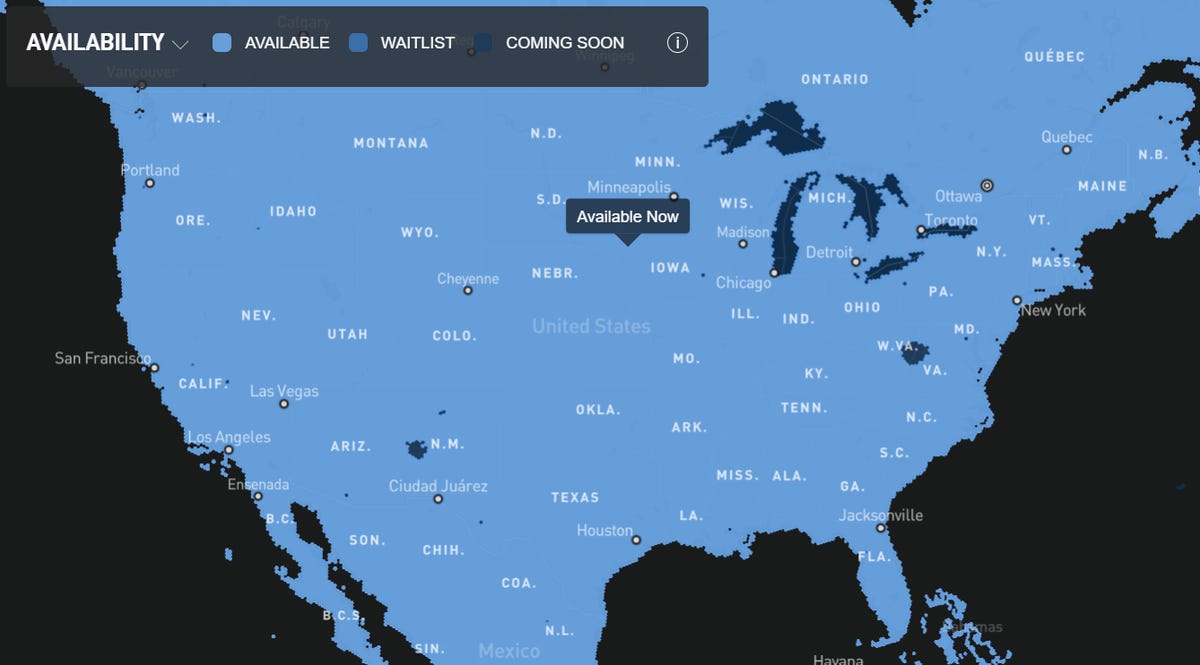Unavailable in Provider unavailable in 90001
Pros
- Decent speeds for a rural connection
- Low latency
- Unlimited data
- Mobile internet available
Cons
- High upfront costs
- Slower than cable or fiber internet
- Vulnerable to inclement weather
Starlink internet plans and pricing
| Starlink plan | Monthly price | Speed range | Equipment costs | Data allotment |
|---|---|---|---|---|
| Standard | $120 | 25-100Mbps | $599 upfront | Standard unlimited |
| Priority | $140-$1,500 | 40-220Mbps | $2,500 upfront | 40GB-6TB, standard unlimited thereafter |
| Mobile | $150 | 5-50Mbps | $599 upfront | Standard unlimited |
| Mobile Priority | $250-$5,000 | 40-220Mbps | $2,500 upfront | 50GB-5TB, standard unlimited thereafter |
Show more (0 item)
In rural areas where internet options are limited at best, an unlimited broadband connection suitable for nearly any use is priceless. Elon Musk and his satellite internet venture, Starlink, have put a price to it, however: around $120 per month.
As one who has closely evaluated dozens, if not 100-plus, internet providers, I’ll say that Starlink’s monthly rate, not to mention the hefty equipment fee due at signup, is higher than average for home internet. Considering the expected speeds and cost per Mbps, Starlink is downright expensive compared to most top internet providers.
That said, it’s not a bad deal for rural internet, especially taking into account the unlimited data and low latency. If you’re outside the reach of cable or a local fiber internet service, Starlink is certainly worth a closer look once you get past the sticker shock.

Better service helps justify Starlink’s cost
While I’d like to see a bit more speed for the price, or a lower price altogether, Starlink adds value in areas where other satellite services cannot.
Starlink has the potential to offer moderately faster speeds than Hughesnet or Viasat (not to mention other popular rural internet options) with home internet speeds ranging from 25 to 220Mbps. For comparison, Hughesnet and Viasat top out at around 100Mbps in most areas.
Service also comes with truly unlimited data. The Standard home internet plan includes unlimited data while the Priority plan comes with 40GB, 1TB or 2TB of “priority” data depending on the tier you choose.
Priority data gives users network precedence over Standard users, potentially delivering faster speeds that are less vulnerable to network congestion. Once your priority data pool is exhausted, the service switches over to standard data. When that happens, bandwidth is prioritized the same as everyone else on the network at any given time.
That can result in slower speeds for the remainder of the billing cycle, but it’s far less of a penalty compared to the substantial and intentional speed throttling Hughesnet and Viasat can enforce once customers surpass their monthly data allotment.
Latency low enough for online gaming
Another advantage to Starlink is low latency. Sometimes called “ping,” latency measures the time it takes for information to travel to and from your internet provider. Geostationary satellites, like those employed by Hughesnet and Viasat, orbit some 22,000 miles above the Earth, resulting in the highest latency of any modern internet connection.
Starlink satellites zip around the planet at an altitude of around 350 miles — 60 times closer to the Earth’s surface than traditional satellites, per the company’s claims — so it takes far less time to transfer information back and forth.
As a result, Starlink’s latency is comparable to cable internet and other terrestrial connection types. Most customers should see latency low enough to support online gaming and avoid excessively lagging video calls.
High equipment fees, but no installation costs
You might pay more month-to-month with Starlink than Hughesnet and Viasat, but you’ll almost certainly pay more upfront thanks to high equipment purchase fees.
Both Hughesnet and Viasat have lower equipment fees than Starlink. Purchasing equipment from Hughesnet or Viasat can cost around $300, while Starlink charges double that at $599.
Hughesnet and Viasat also give you the option to skip the upfront fee and lease equipment from for an additional $13 to $15 per month. No such option is available with Starlink; customers purchase the equipment and after 30 days, it’s theirs to keep.
While more expensive, Starlink equipment is apparently simple to set up (as seen in the video below) and does not require professional installation. Hughesnet and Viasat, on the other hand, require professional installation, which can add $100 or more to your upfront costs.
New Starlink Mini dish could lower equipment costs
Rumors of a new Starlink Mini dish are circulating, and word is it may cost half as much as the standard equipment. That would bring the equipment purchase cost below that of Hughesnet or Viasat.
The smaller device, “small enough to fit in a backpack,” apparently, appears to be geared toward the roaming service rather than home internet, however. Its slim design and lower cost will likely come with compromising for slower speeds, and Starlink’s home internet speeds are already at around the minimum of what I would recommend for everyday home use.

Watch this: Testing Out SpaceX Starlink Satellite Internet
Starlink setup seems surprisingly simple
Professional installation isn’t available with Starlink, but the self-install process seems fairly straightforward. Starlink offers several mounting options for rooftops, yards and the exterior of your home. There’s even a Starlink app for Android and iOS that uses augmented reality to help customers pick the best location and position for their receivers.
In 2021, CNET’s John Kim signed up for Starlink at his home in California and began testing it at various locations. At home, he averaged download speeds of around 78Mbps and latency of around 36ms. You can see more of his first impressions in the video above.

Starlink availability: ready nearly everywhere in the US
According to Federal Communication Commission data from December 2023, Starlink is available to 99.6% of US households. That’s the highest coverage percentage of any internet provider, including Hughesnet and Viasat.
There are a few pockets, specifically in southern California, West Virginia and New Mexico, where service is “coming soon.” Still, Starlink’s coverage is impressive. I ran serviceability checks using addresses from California to Connecticut and down south in Alabama and rural Texas and received a response indicating that “Starlink is immediately available” every time.
Service isn’t limited to just the US. Per Musk, the list of countries currently served by the growing network of low-orbit satellites includes the US, Canada, the UK, France, Germany, Austria, the Netherlands, Ireland, Belgium, Switzerland, Denmark, Portugal, Australia, New Zealand and others.
Starlink’s fleet expansion continues at a rapid rate
By the end of April, Starlink had launched just shy of 30 new satellite payloads in 2024, adding more than 600 new satellites to the fleet of nearly 6,000 functional satellites. There’s still a way to go. Starlink will likely need at least 10,000 satellites in orbit before it can claim to offer full service to most of the globe, and SpaceX has shown signs that it wants as many as 42,000 satellites in the constellation.
What does this mean for Starlink internet?
Ideally, Starlink’s coverage and speeds will improve with every launch. Starlink’s website says, “Starlink users typically experience download speeds between 25 and 220Mbps, with a majority of users experiencing speeds over 100Mbps.” The internet speed-tracking site Ookla reported that Starlink offered average download speeds of nearly 67Mbps in the US during the first quarter of 2023.
That’s down significantly from the end of 2021 when Starlink had median download speeds of just over 100Mbps. The drop may be the result of growing subscriptions and increased network congestion. Hopefully, average speeds will jump back up to around 100Mbps or higher soon as groups of new satellites are added to the fleet.
How does Starlink compare?
Starlink isn’t replacing your fiber, cable or even fixed wireless connections like Verizon 5G Home Internet and T-Mobile Home Internet just yet, or possibly ever. That doesn’t seem to be the intent behind the service. Starlink is best suited to provide a practical solution for broadband in underserved areas or in a mobile sense, where traditional wired or fixed wireless services are unavailable.
Such areas have previously had two internet options: Hughesnet or Viasat. Starlink has emerged as a third option, so how does it compare to its satellite internet rivals?
Hughesnet can be a bit cheaper per month than Starlink, with standard rates of $75 to $110 for max download speeds of 50 or 100Mbps. Viasat’s standard rates range from $100 to $400 per month depending on your plan, so Starlink may be a cheaper option than Viasat despite the faster speed potential, unlimited data and lower latency.
Pricing can be a toss-up between all three satellite providers depending on the ISP or plan you choose and the route you go with the equipment. Starlink holds the advantage in basically every other category, however, including max speeds, latency, data allowances and contract requirements.
What’s the final word on Starlink?
Starlink is an exciting and much-needed addition to rural internet’s long-limited landscape. Although service is slower and more expensive than many other providers and connection types, the relatively high speed potential, low latency, unlimited data and no contract requirements boost its value as a rural internet provider.
Starlink internet FAQs
Does bad weather affect Starlink?
Struggles with inclement weather are a definite downside to satellite internet. Per Starlink’s FAQ, the receiver can melt snow that lands on it, but it can’t do anything about surrounding snow build-up and other obstructions that might block its line of sight to the satellite.
“We recommend installing Starlink in a location that avoids snow build-up and other obstructions from blocking the field of view,” the FAQ reads. “Heavy rain or wind can also affect your satellite internet connection, potentially leading to slower speeds or a rare outage.”
Can you see Starlink satellites in the sky?
Concern about the proliferation of privately owned satellites in space and controversy in astronomical circles about the impact of low-orbiting satellites on the night sky is not uncommon.
In 2019, shortly after Starlink’s first broadband satellite deployment, the International Astronomical Union released an alarm-sounding statement warning of unforeseen consequences for stargazing and the protection of nocturnal wildlife.
“We do not yet understand the impact of thousands of these visible satellites scattered across the night sky and despite their good intentions, these satellite constellations may threaten both,” the statement reads.
Since then, Starlink has begun testing various designs intended to reduce the brightness and visibility of its satellites. At the start of 2020, the company tested a “DarkSat” satellite with a special, non-reflective coating. Later, in June 2020, the company launched a “VisorSat” satellite that features a special sunshade visor. In August, Starlink launched another batch of satellites — this time, they all were equipped with visors.
“We want to make sure we do the right thing to make sure little kids can look through their telescope,” Shotwell said. “It’s cool for them to see a Starlink. But they should be looking at Saturn, at the moon … and not want to be interrupted.”
“The Starlink teams have worked closely with leading astronomers around the world to better understand the specifics of their observations and engineering changes we can make to reduce satellite brightness,” the company website reads.
Where can I learn more about Starlink?
We’ll continue to cover Starlink’s progress from various angles here on CNET, so stay tuned. You should also keep track of Eric Mack’s excellent work covering Starlink. Among other issues, he closely examines the project’s goals and challenges and the implications for underserved internet consumers and astronomers concerned with light pollution obstructing views in the night sky.
Beyond that, we expect to continue testing Starlink’s network for ourselves as it expands. When we know more about how the satellite service stacks up as an internet provider, we’ll tell you all about it.





